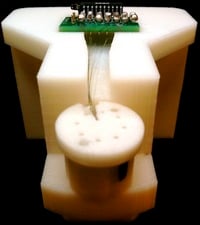 Leslie Langau tells an amazing story of how a 3D printer was used to treat stroke patients. Professor Robert Rennaker II at the Erik Jonsson School of Engineering and the School of Behavioral and Brain Sciences at the University of Texas in Dallas has been doing experiments simulating the various disabilities of stroke victims.
Leslie Langau tells an amazing story of how a 3D printer was used to treat stroke patients. Professor Robert Rennaker II at the Erik Jonsson School of Engineering and the School of Behavioral and Brain Sciences at the University of Texas in Dallas has been doing experiments simulating the various disabilities of stroke victims. Post-stroke, a patient often loses the ability to move a hand. Rennaker uses his research to simulate this disability with his lab subjects. The subjects place a paw in a hole with a wheel at the bottom, when the subjects rotate the wheel they are given a food reward. The device forces the subject to use its paw instead of its whole leg. The group is studying the effect of stimulating the Vagus nerve while performing the task in an attempt to facilitate and expedite recovery of function in the limb affected by the stroke.
The professor uses 3D printed parts to quickly produce models precisely matched to the experiment – and by using a 3D printing approach, he can produce the necessary parts immediately rather than waiting for service bureau turnaround.
Via MakePartsFast

